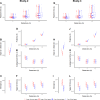Self-relevant facial threat attracts peripheral attention
- PMID: 40883375
- PMCID: PMC12397305
- DOI: 10.1038/s41598-025-15695-1
Self-relevant facial threat attracts peripheral attention
Abstract
Threat-relevance theory suggests that gaze direction determines the self-relevance of facial threats. Indeed, angry eye-contact is a more relevant threat compared to its counterpart with averted gaze. Similarly, fearful eye-contact is not a threat to the observer, but averted fearful gaze can signal a relevant threat nearby. Following evidence that amygdala-reactivity to self-relevant threat depends on coarse visual processing, we investigate whether self-relevant threat attracts attention due to processing of low spatial frequency information via peripheral vision. Furthermore, we aim to provide behavioral relevance to this mechanism by investigating whether the psychopathic trait fearless-dominance promotes attention to self-relevant anger. Across three studies (N = 12, 31 and 36), we find that, during visual-search for emotional faces, less gaze-fixations are needed to find facial fear and anger when they are self-relevant. Self-relevance, however, does not promote peripheral identification of fear and anger in a signal-detection experiment. Together, this confirms that self-relevant facial threats indeed attract peripheral-attention. Moreover, image-analysis suggests that this is due to their low spatial-frequency content. Lastly, peripheral-attention to angry eye-contact is indeed more pronounced in relation to the psychopathic trait fearless-dominance, while diminished in relation to the psychopathic trait impulsive-antisociality, which provides preliminary behavioral relevance to this mechanism.
Keywords: Fearless dominance; Image statistics; Impulsive antisociality; Psychopathy; Response modulation theory; Visual search.
© 2025. The Author(s).
Conflict of interest statement
Declarations. Competing interests: The authors declare no competing interests.
Figures




Similar articles
-
Prescription of Controlled Substances: Benefits and Risks.2025 Jul 6. In: StatPearls [Internet]. Treasure Island (FL): StatPearls Publishing; 2025 Jan–. 2025 Jul 6. In: StatPearls [Internet]. Treasure Island (FL): StatPearls Publishing; 2025 Jan–. PMID: 30726003 Free Books & Documents.
-
Facial features associated with fear and happiness attract gaze during brief exposure without enhancing emotion recognition.Sci Rep. 2025 Aug 19;15(1):30442. doi: 10.1038/s41598-025-12327-6. Sci Rep. 2025. PMID: 40830151 Free PMC article.
-
Distinct contributions of foveal and extrafoveal visual information to emotion judgments and gaze behavior for faces.J Vis. 2025 Jul 1;25(8):4. doi: 10.1167/jov.25.8.4. J Vis. 2025. PMID: 40600755 Free PMC article.
-
Meanness and affective processing: A meta-analysis of EEG findings on emotional face processing in individuals with psychopathic traits.Biol Psychol. 2024 Mar;187:108764. doi: 10.1016/j.biopsycho.2024.108764. Epub 2024 Feb 11. Biol Psychol. 2024. PMID: 38350594 Review.
-
How lived experiences of illness trajectories, burdens of treatment, and social inequalities shape service user and caregiver participation in health and social care: a theory-informed qualitative evidence synthesis.Health Soc Care Deliv Res. 2025 Jun;13(24):1-120. doi: 10.3310/HGTQ8159. Health Soc Care Deliv Res. 2025. PMID: 40548558
References
-
- Adams, R. B., Gordon, H. L., Baird, A. A., Ambady, N. & Kleck, R. E. Effects of gaze on amygdala sensitivity to anger and fear faces. Sci. (1979). 300, 1536 (2003). - PubMed
-
- Adams, R. B. & Kleck, R. E. Effects of direct and averted gaze on the perception of facially communicated emotion. Emotion5, 3–11 (2005). - PubMed
-
- Adams, R. B. & Kleck, R. E. Perceived gaze direction and the processing of facial displays of emotion. Psychol. Sci.14, 644–647 (2003). - PubMed
MeSH terms
LinkOut - more resources
Full Text Sources

